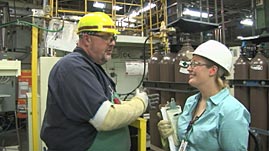Teachers' Domain - Digital Media for the Classroom and Professional Development
User: Preview

Source: Pennsylvania College of Technology/WVIA
This video segment adapted from Pennsylvania College of Technology and WVIA features Jennifer Brinkley-Cruz, a manufacturing specialist with Toyota's Georgetown, Kentucky, manufacturing plant. Learn about her workday and her responsibilities in a part of the plant called body weld. While robots make 97 percent of the welds used to build vehicles in this plant, Brinkley-Cruz explains that humans are needed to oversee their operation. Brinkley-Cruz also discusses the importance of her welding education in landing her job as supervisor.
Welding is an important part of the manufacturing process in a broad range of industries. Whether welders are working in an airplane hanger, on a construction site, or in an automobile assembly plant, their job is essentially the same. Welding is the joining together of two materials—usually metals or plastics—through the application of heat. Individuals who are mechanically inclined, enjoy putting things together, and possess good hand-eye coordination may be especially well suited for a career in welding.
Although some welding employers provide training, they typically prefer to hire entry-level workers who already have some formal education and experience. To prepare for a welding career, individuals can enroll in training programs offered through vocational schools, community colleges, or dedicated welding schools. Even some high schools offer specialized courses. In addition to providing hands-on training in various welding techniques, training programs provide instruction in such essential subjects as blueprint reading, mechanical drawing, shop mathematics, physics, chemistry, metallurgy, and electricity.
With robotics and other computer-controlled machinery replacing some of the lower-skill welding processes in the industrial workplace, the ability to operate computers and oversee the welders' work is becoming an increasingly important skill for career seekers to possess. While robots may offer the promise of lower costs, they cannot be employed everywhere. Human welders are still needed to perform on-site repair of bridges, roadways, and other aging transportation infrastructure.
Training and education in welding can help prepare an aspiring welder for lots of interesting careers both on and off a factory floor. Jobs can be found in underwater welding, operating welding machines, pipefitting or plumbing, and even metalsmithing—using welding tools to turn precious metals into jewelry or art. The basic skills of welding are the same across industries, so welders can easily shift from one industry to another depending on where they are needed most.
With the demand for skilled technicians growing faster than the supply, a shortage of skilled welders is expected. While a shortage like this often leads industries to look overseas for workers, many plant operators are focusing on expanding domestic workforce options. One potential resource pool may be women. Currently, less than one percent of employed welders are female. Yet, as the welding supervisor featured in this video proves, women with the motivation and proper training can be a valuable part of the welding industry. Women often excel in welding jobs that put a premium on hand-eye coordination and fine detail work.
 Loading Standards
Loading Standards Teachers' Domain is proud to be a Pathways portal to the National Science Digital Library.
Teachers' Domain is proud to be a Pathways portal to the National Science Digital Library.
